Cryptic Critters on Whips, Crinoids, and in the Dirt
 June 7, 2013
June 7, 2013

Not only are we on an expedition, we’re on an expedition in really turbid waters. Losing your buddy is a given. But you won’t be able to do any work at all if you lose your equipment. So the less things you have to focus on getting a grip on, the better. In an attempt to keep his hands free (and look like a Gearhead) Dr Tan Heok Hui, who’s a fish biologist with the Raffles Museum of Biodiversity and Research, dons his helmet fitted with light and camera for our first dive at Pulau Hantu!
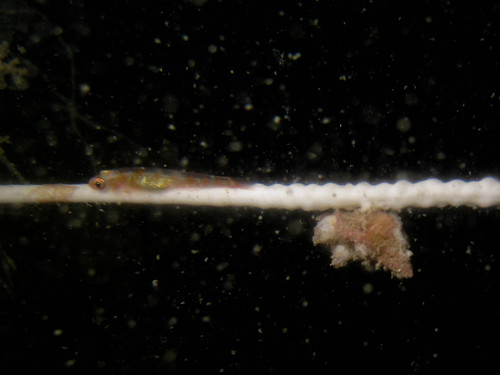
The visibility at Pulau Hantu was horrible. It it weren’t for the light on my buddy’s head I would have lost him immediately (I lost him after about 20 minutes). But I did find some cool things on whips, like this goby.
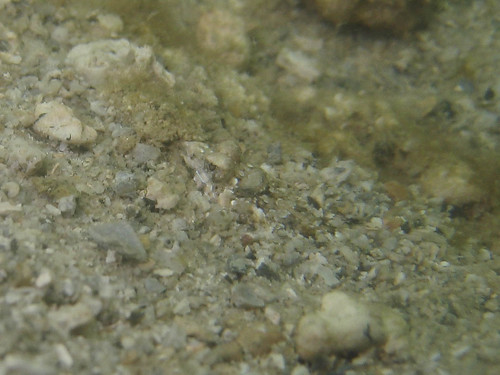
There were several of these little fish on the reef flat. They are either dragonets or tiny flatheads. I am more inclined to think they are dragonets of sort because they have a rather short snout for a flathead. However they do bury in sand. Can you see it?
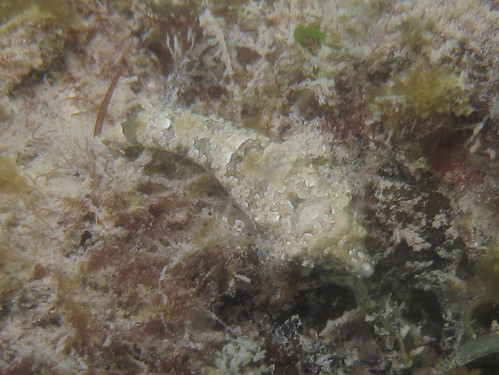
Here is the same fish out of the sand and on top of the coral rubble. They are extremely quick and agile!
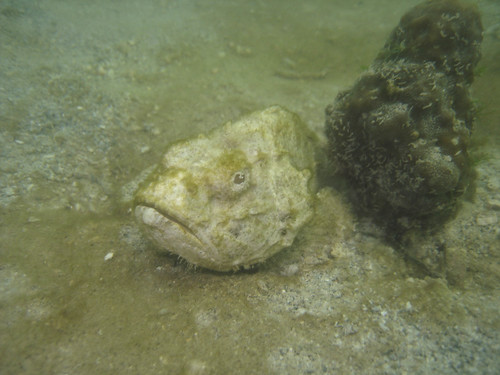
Though it has done a good job changing its colour to match the surrounding sandy environment, this Scorpionfish (Scorpaenopsis sp.) could take some camouflage advice from the little dragonet-like fish. While it has got its body well hidden, its head is clearly sticking out on the reef flat! That algae that encrusts its body is very cool though. Contrary to what some people might think, Scorpionfishes are not aggressive, but if threatened they will erect their dorsal spines. If danger continues they flee, usually very fast but only for a short distance and then quickly settle back and freeze. The stonefishes for example usually bury themselves in sand or rubble using a shoveling motion of their pectoral fins. In a matter of less than 10 seconds only the dorsal portion of the head remains exposed, some sand is thrown on top to further enhancing concealment. Some species like the devilfish have very bright red and yellow colors on the inner surface of their pectoral fins. Those colors are not visible when resting but are flashed if threatened. [1]
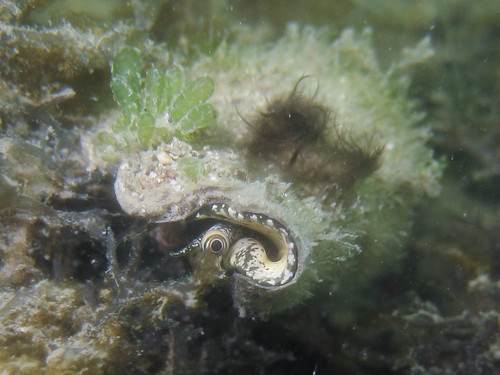
Another critter that’s working very hard to stay hidden is this conch, that has even managed to pluck bits of algae and cyanobacteria onto its shell surface to break up its outline!
At Tekukor Island, I found some beautiful anemones on sea whips!
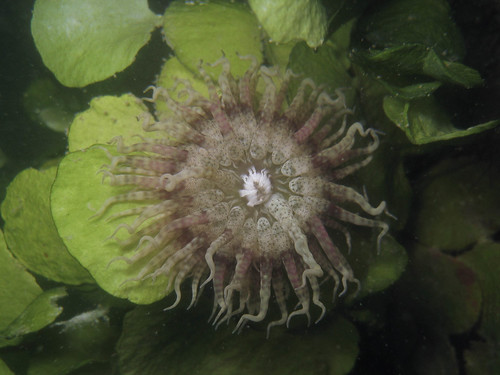
There were also anemones on the algae.
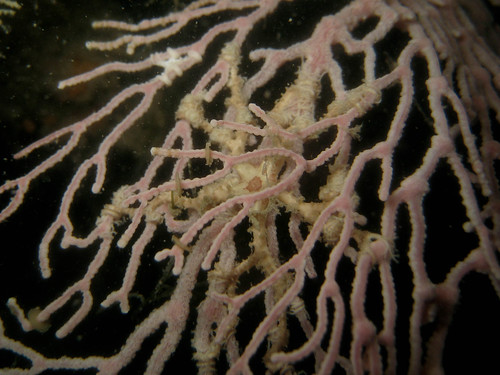
And plenty of Basket stars holding on tight to the seafans. I found out that Basket stars are are kind of specialised Brittle star! In fact, they are the largest of the Brittle stars, some capable of growing up to 70 cm in arm length with a center disk diameter of 14 cm! In the wild, Basket stars can live up to 35 years and grow to weigh 5 kilos! I’m not sure I would find such a monster quite so cute and feel confident to swim up to it with the risk of getting my fingers entangled in its arms! Thank goodness they have no teeth.
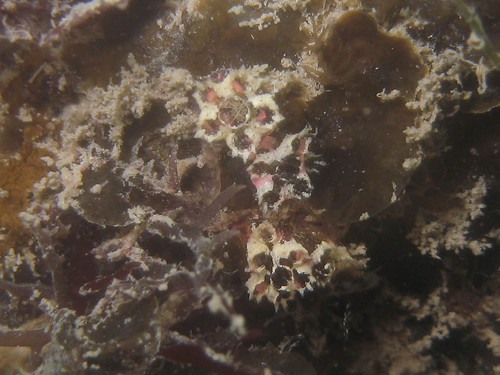
There were colonies of ascidians that looked like flowers.
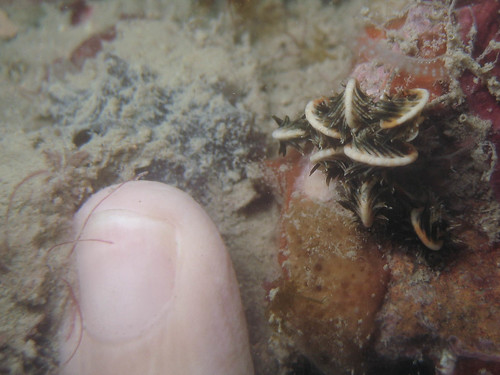
And crinoids the size of my pinkie nail!
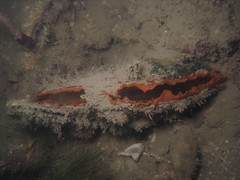
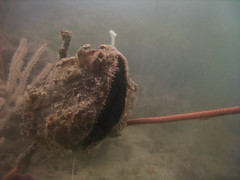
There were bivalves everywhere! Some make their home in the dirt, others perch themselves upon skinny sea whips!

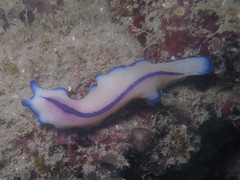
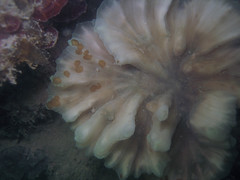

There were big and beautiful flatworms, but also small Acoel flatworms (Waminoa sp.) that glide their ultra-thin bodies over the coral surface as they graze, probably eating organic debris trapped by coral mucus. Though they resemble flatworms in many respects, they have a simpler anatomy, no gut, and lack an excretory system. They have no body cavities such as a hindgut or an anus. They have no true brain, just a simple nerve network beneath their skin, with a concentration of nerves toward the forward end of the animal. [2]

Other simple creatures on the reef included this Synaptid seacucumber on a barrel sponge. Synaptids have a thin body wall and are more delicate than other sea cucumbers. Synaptid sea cucumbers don’t have tube feet. Instead, they may stick to things with tiny hooked sclerites that poke out of their soft bodies. This is why they stick to our hands if we touch them. They have thin body walls and are fragile, so we should not handle them. [3]
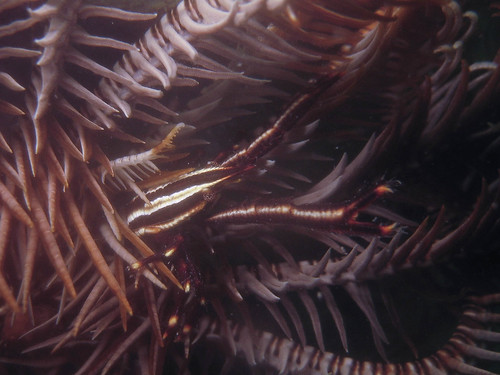
To wrap up the day I found a few of these Elegant squat lobsters (Allogalathea elegans) in some of the many crinoids that were perched upon the sea fans, sea whips, and sponges throughout Tekukor’s reefs.
Here are the Tweets I posted from today’s expedition:
Thunder and lightning, very very frightening. #megamarine http://twitpic.com/csqaon
First #megamarine dive at Kusu Is. this morning, so many Crinoids, shrimp, anemones, slugs, flatworms & basket stars! http://twitpic.com/csrcug
Pulau Jong: Many sea slugs, parrotfish, a shark and a ray. No luck with Janss pipefish though. #megamarine http://twitpic.com/cssg02
Many sap-sucking sea slugs, Elysia chlorotica, at Jong and Kusu today! Big, fat ones. #megamarine http://twitpic.com/csshnm
Look what we found under a magnificent anemone this morning! #megamarine http://twitpic.com/cssiwh
Back fr 1st dive at Hantu. Absolutely horrid visibility! Found stonefish, grouper, conch, ctenophores! #megamarine http://twitpic.com/ct068b
One very unhappy stonefish. Jumped out of bucket, landed on Zeehans toe! Was white, now mottled brown. #megamarine http://twitpic.com/ct06wt
Sponges get inspected for commensals. #megamarine http://twitpic.com/ct1yxp
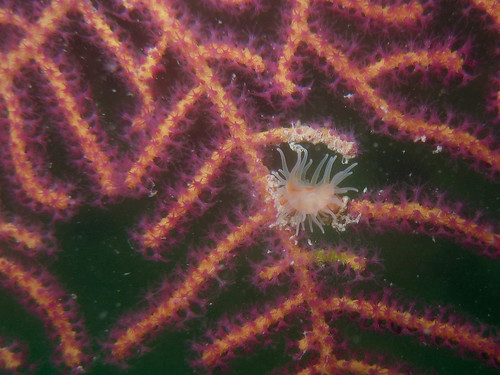


 Posted in
Posted in 



 content rss
content rss
COMMENTS